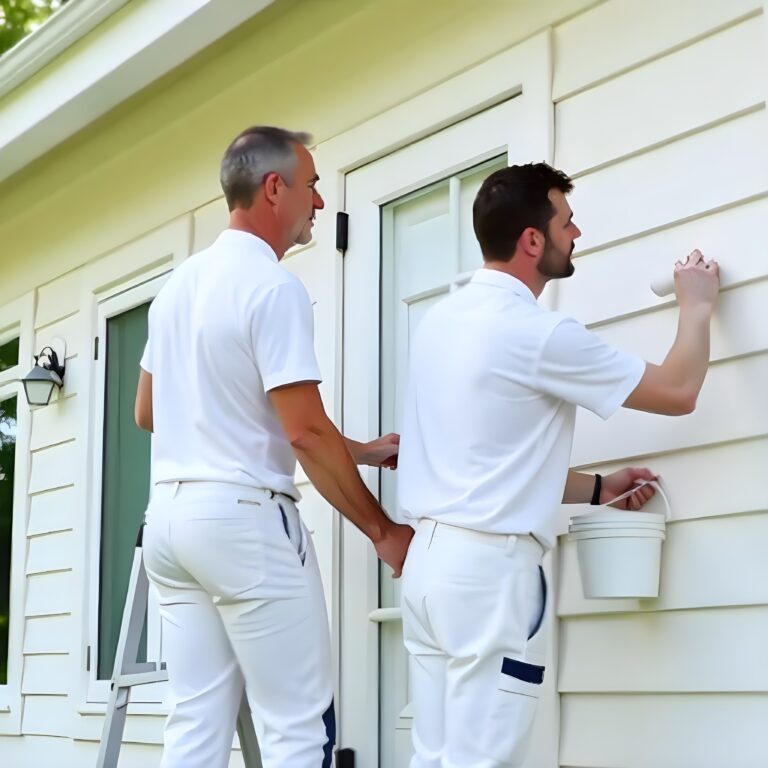If you’ve been walking the aisles of Bunnings or scrolling online for paint, you might’ve caught yourself thinking, Can I Use Exterior Paint for Interior?
You’re not alone, heaps of homeowners and DIYers ask the same thing. And as someone who’s painted more houses than I can count across Liverpool and beyond, here’s the honest truth:
Yes, you can use exterior paint inside. But it’s not something I’d recommend and here’s why.
Exterior vs Interior Paint – There’s a Real Difference
Let’s start with what makes them different.
Exterior paint is built to take on everything the Aussie climate throws at it—rain, harsh sun, temperature swings, and humidity. That means it’s made with stronger additives, UV blockers, and mildew sides to fight off mold and fading. It’s built like armour for your weatherboards.
But that same toughness makes it a poor fit for indoor spaces. Why?
Because most exterior paints contain higher VOCs (volatile organic compounds)—those are the fumes that can hang in the air for days. In a closed-up room, that’s not just annoying—it can be genuinely unhealthy, especially for kids or anyone with allergies.
And from a painter’s perspective? It just doesn’t perform as well inside. It doesn’t cure the same way, it can stay tacky longer, and it’s harder to clean over time.
So while it sounds like a good idea—it’s not worth the headache. Use interior paint where it’s meant to go. You’ll thank yourself later.
Before painting, ensure your furniture’s been safely moved. furniture removalists perth can help protect your belongings during a reno.
Weather Matters When You’re Painting Outside
Now, if you’re working on the outside of your home, weather conditions play a massive role in how your paint job turns out. Trust me, I’ve seen perfect work ruined by rushing it on the wrong day.
Too Cold – Hold Off
If it’s under 10°C, don’t bother painting with water-based (latex) paint. It just doesn’t dry properly and can peel or crack later on. Oil-based paints can handle a bit cooler, down to about 5°C, but still—not ideal.
Too Hot – Also a Problem
On the flip side, if you’re painting in temps over 35°C, especially in direct sun, the paint can dry too fast. That leads to brush marks, flaky coverage, or even bubbling. No one wants to see their hard work melt away—literally.
Best Time of Day for Exterior Painting
Here’s a rule I follow on every outdoor job: paint mid-morning to early arvo, ideally between 10am and 2pm. By then, the morning dew’s dried off, and the surface has warmed up enough to help the paint stick. Plus, you’re avoiding the intense heat of late afternoon.
Real-World Tips from a Painter Who’s Been There
Always check the weather forecast. I plan my week around it—don’t trust the sky alone.
Use season-appropriate paint. Some paints are made for cooler or warmer weather—check the tin.
Skip windy days. Dust and debris will ruin a fresh coat.
Prepping matters more than you think. A clean, dry surface is the secret to long-lasting paint never skip this step.
Final Thoughts
Look, I get it painting your home is more than just a weekend job. It’s emotional. It’s your space, your comfort zone, your investment. And you want it to look and feel right.
At Liverpool, we’ve been painting homes across the area for years, and we always give advice we’d follow ourselves. So, if you’re thinking about using exterior paint indoors don’t. It might save you a trip to the shop now, but it could cost you in health and headaches later.
If you ever feel unsure, give us a call. Whether you’re a DIYer who just needs a bit of guidance, or you want a professional to take it off your plate, we’re here to help.
You’ve got this and we’ve got your back if you need a hand.
FAQ
1. Can I use exterior paint inside my home?
While you can use exterior paint indoors, it’s generally not recommended. Exterior paint contains additives and chemicals designed to withstand weather and UV rays, which can release stronger fumes and may not be ideal for enclosed spaces.
2. Is it safe to use exterior paint inside a room?
Not really. Exterior paints often emit higher levels of volatile organic compounds (VOCs), which can cause headaches, dizziness, or respiratory issues—especially in poorly ventilated areas.
3. What happens if I accidentally use exterior paint indoors?
If it’s already applied, make sure the area is well-ventilated while the paint cures. Over time, it might yellow or become tacky, and it could impact indoor air quality. In high-traffic areas, it may also not hold up as well as quality interior paint.
4. Why is exterior paint not suitable for interior surfaces?
Exterior paint is formulated to resist mould, mildew, and weathering, which makes it softer and more flexible. Indoors, this flexibility isn’t needed—and it may result in less durability, a stronger odour, and longer drying times.
5. Can I mix exterior and interior paints for indoor use?
It’s not advised. Mixing them can affect the paint’s chemical composition, drying process, and finish. For best results and safety, always stick to paint that’s specifically made for interior use.





